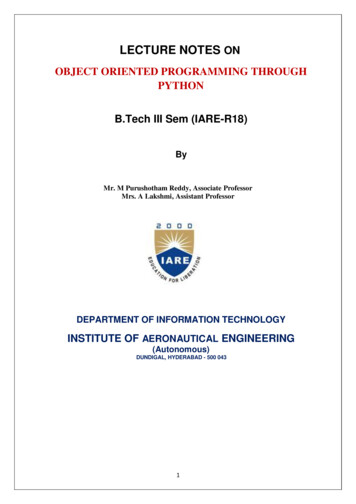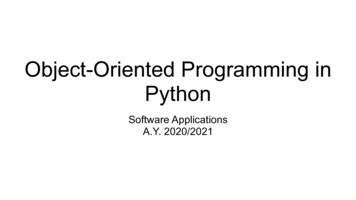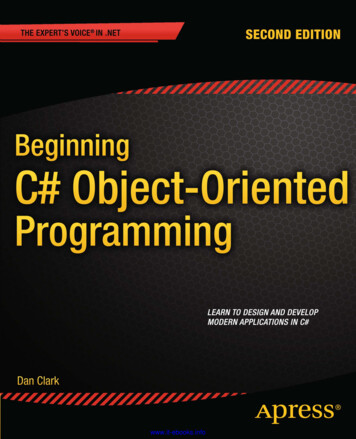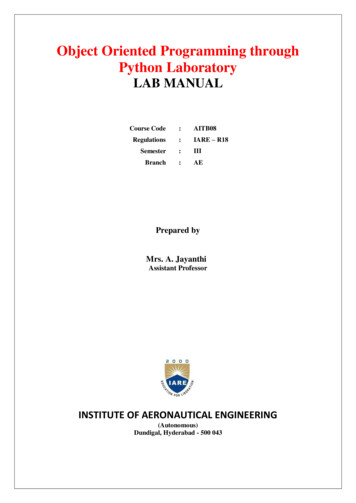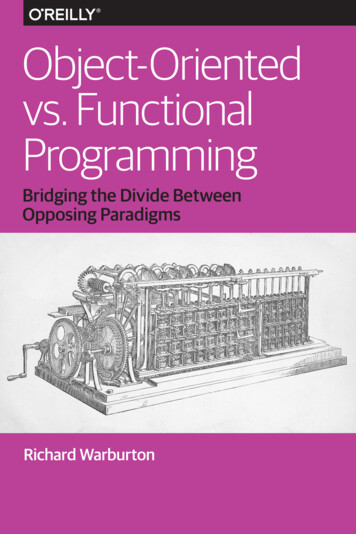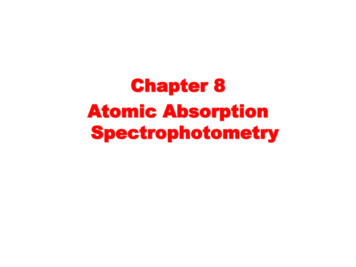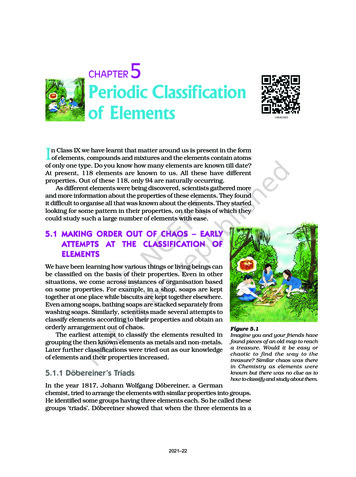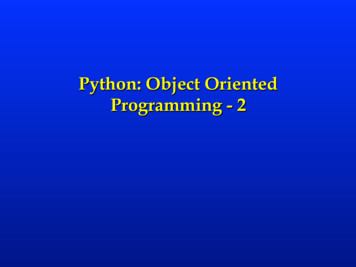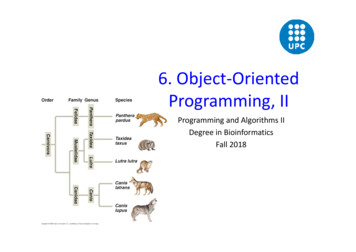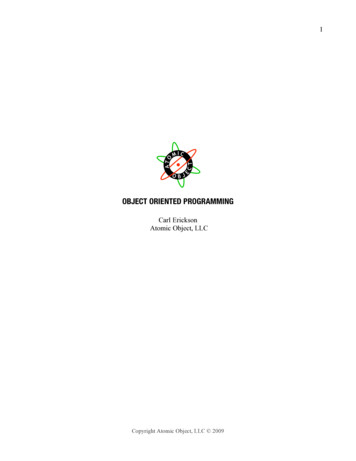
Transcription
1OBJECT ORIENTED PROGRAMMINGCarl EricksonAtomic Object, LLCCopyright Atomic Object, LLC 2009
2TABLE OF 18.19.20.21.22.23.24.Motivation for Object Oriented Programming . . . 3The Object Oriented Paradigm . . . 8Visualizing Program Execution . . . 10Naming Conventions . . . 14The Object Model . . . 15Abstraction and Identity . . . 16Object Oriented Messaging . . . 26Encapsulation and Modularity . . . 28Object Oriented Hierarchy . . . 29Object Oriented Typing . . . 30Object Oriented Concurrency and Persistence . . . 33Object Oriented Development Process . . . 35Object Oriented Analysis Techniques . . . 36Pitfalls in Object Oriented Analysis . . . 38UML Notation . . . 40CRC Cards . . . 46Object Oriented Class Relationships . . . 47Object Oriented Aggregation . . . 48Object Oriented Inheritance . . . 50Other Object Oriented Class Relationships . . . 56Object Oriented Instantiation . . . 57Object Oriented Polymorphism . . . 58Object Oriented Concepts Review . . . 62Quality of Classes and Object Oriented Design . . . 63Copyright Atomic Object, LLC 2009
31. MOTIVATION FOR OO PROGRAMMING1.1 OO DIDN’T COME OUT OF THE BLUE OO has strong historical roots in other paradigms and practices. It came about to address problemscommonly grouped together as the “software crisis.”Applied improperly, or by people without the skills, knowledge, and experience, it doesn’t solve anyproblems, and might even make things worse. It can be an important piece of the solution, but isn’t aguarantee or a silver bullet.1.2 COMPLEXITYSoftware is inherently complex because we attempt to solve problems in complex domains we are forced by the size of the problem to work in teams software is incredibly malleable building material discrete systems are prone to unpredictable behavior software systems consist of many pieces, many of which communicateThis complexity has led to many problems with large software projects. The term “software crisis” wasfirst used at a Nato conference in 1968. Can we call something that old a crisis? The “software crisis”manifests itself in cost overruns user dissatisfaction with the final product buggy software brittle softwareSome factors that impact on and reflect complexity in software: The number of names (variables, functions, etc) that are visible Constraints on the time-sequence of operations (real-time constraints) Memory management (garbage collection and address spaces) Concurrency Event driven user interfacesHow do humans cope with complexity in everyday life?AbstractionHumans deal with complexity by abstracting details away.Examples: Driving a car doesn’t require knowledge of internal combustion engine; sufficient to think of acar as simple transport. Stereotypes are negative examples of abstraction.To be useful, an abstraction (model) must be smaller than what it represents. (road map vs photographsof terrain vs physical model).Copyright Atomic Object, LLC 2009
4Exercise 1Memorize as many numbers from the following sequence as you can. I’ll show them for 30 seconds.Now write them 4 How many did you remember? How many could you remember with unlimited amounts of time?Exercise 21How many of these concepts can you memorize in 30 seconds?Exercise 3Write down as many of the following telephone numbers as you can Home: Office: Boss: Co-worker: Parents: Spouse’s office: Fax:1Miller (Psychological Review, vol 63(2)) “The Magical Number Seven, Plus or Minus Two: Some Limits on Our Capacityfor Processing Information”Copyright Atomic Object, LLC 2009
5 Friend1: Friend2: Local Pizza:By abstracting the details of the numbers away and grouping them into a new concept (telephonenumber) we have increased our information handling capacity by nearly an order of magnitude.Working with abstractions lets us handle more information, but we’re still limited by Miller’sobservation. What if you have more than 7 things to juggle in your head simultaneously?HierarchyA common strategy: form a hierarchy to classify and order our abstractions.Examples: military, large companies, Linaen classification systemDecompositionDivide and conquer is a handy skill for many thorny life problems. One reason we want to compose asystem from small pieces, rather than build a large monolithic system, because the former can be mademore reliable. Failure in one part, if properly designed, won’t cause failure of the whole. This depends onthe issue of coupling.Tightly coupled systems of many parts are actually less reliable. If each part has a probability of beingimplemented correctly of p, and there are N parts, then the chance of of the system working is pN. WhenN is large, then only if p is very close to 1 will the system operate.We can beat this grim view of a system composed of many parts by properly decomposing anddecoupling.Another reason is that we can divide up the work more easily.Postpone obligationDelaying decisions that bind you in the future for as long as possible preserves flexibility.Deciding too quickly makes change more likely. The cost of change depends on when it occurs.Consider the traditional waterfall development model, and the cost of change during the lifecycleof a project.Copyright Atomic Object, LLC 2009
61.3 OO TECHNOLOGYAbstractionsNothing unique about forming abstractions, but in OO this is a main focus of activity and organization.We can take advantage of the natural human tendency to anthropomorphism.We’ll call our abstractions objects.HierarchyWe’ll put our abstractions into a hierarchy to keep them organized and minimize redundancy.This can be overrated in OO.DecompositionWhether we do our decomposition from a procedural, or algorithmic, point of view or from an OO pointof view, the idea is the same: divide and conquer, avoid thinking of too much at once, use a hierarchy tofocus our efforts.In algorithmic decomp, we think in terms of breaking the process down into progressively finer steps.The steps, or the algorithm are the focus.The problem with an algorithmic or top-down design, is that if we make the wrong top-level decisions,we end up having to do all sorts of ugly things down at the leaves of the decomposition tree to get thesystem to work. The killer is that it is hard to judge or test what are good decompositions at the topmostlevel when we know the least about the problem.In OO decomp, we think in terms of identifying active, autonomous agents which are responsible fordoing the work, and which communicate with each other to get the overall problem solved.Advantages of OO decomposition smaller systems through re-use of existing components evolution from smaller, working models is inherent natural way to “divide and conquer” the large state spaces we facePostponing commitmentIn OO, our implementation decisions are easier to postpone since they aren’t visible.Analysis and Design: more work up-front pays off in the long run. Design for genericity – danger of taking too far. Problem of knowing enough of the requirements, tendency to change.Revolution vs. evolutionObject-Oriented technology is both an evolution and a revolutionAs evolution it is the logical descendant of HLL, procedures, libraries, structured programming,and abstract data types.Copyright Atomic Object, LLC 2009
7The revolution of OO technology is on a personal basis. People who are proficient in a structuredprogramming world have learned to think in terms of algorithmic decomposition. This was hardto learn and is even harder to unlearn.Computing as simulationThe primary difference between OT and structured HLLs is the fidelity of the abstraction to thereal world. Fortran forces you into working with abstractions that are computer-language oriented(real, array, do/while). OT lets you describe your problem in terms of the problem space, in otherwords, OT is a modeling and simulation tool, whereas traditional HLL are simply descriptiors ofalgorithms.Where does C sit in this regard? structures but no behavior.The origins of OO programming are found in languages built for simulation.Why OO technology now?30 years old, why only now ubiquitous? More pressure on business to compete (globalization,need for greater productivity, flexibility, innovation, decentralization, empowered users)]Best current means of dealing with complexity (there will be something else someday).1.4 WORKING COMPLEX SYSTEMSBooch identifies five common characteristics to all complex systems:1. There is some hierarchy to the system. A minute ago we viewed hierarchy as something wedid to cope with complexity. This view says that a complex system is always hierarchic.Perhaps people can only see complex systems in this way.2. The primitive components of a system depend on your point of view. One man’s primitiveis another complexity.3. Components are more tightly coupled internally than they are externally. The componentsform clusters independent of other clusters.4. There are common patterns of simple components which give rise to complex behavior.The complexity arises from the interaction or composition of components, not from thecomplexity of the components themselves.5. Complex systems which work evolved from simple systems which worked. Or stated morestrongly: complex systems built from scratch don’t work, and can not be made to work.Copyright Atomic Object, LLC 2009
82. THE OBJECT ORIENTED PARADIGM2.1 METAPHORS Hard boiled eggs Little black boxes Widget factoriesAll are necessarily incomplete, imperfect. The best might actually be a person. This makesanthropomorphizing very easy. This metaphor requires a multi-threaded OO model – interesting, but abit more complicated to start with.2.2 A SIMPLE EXAMPLE(from Bruce Webster, Pitfalls of OO Development)Suppose you bought a nifty device at Radio Shack, a Weather Clock. This device tells you the time,temp, pressure and humidity. Looking at your Radio Shack purchase you would see four gauges tellingyou the four pieces of data. You wouldn’t know what’s inside the device, or how the numbers beingdisplayed were determined. The implementation of getting this data is encapsulated. All you see (and allyou want/need to see) is the interface. Someday RS may change one of their gauges to be more accurate,or cheaper. They wouldn’t have to change the interface, and the user would never know a change tookplace.What if you want two weather clocks, one for the living room and one for the kitchen? Just buy anotherinstance of the nifty RS device – own two of them. They are distinct, show different data, reside indifferent places, have different identities, but they are two of the same thing, a Weather Clock. Justbecause you own two of them doesn’t mean that RS had to re-invent a new Weather Clock. They just rananother on off the factory for you. Since you already owned one of them, using the new one in thekitchen is easy – the interface is identical. Is the implementation the same?What if you go back to RS and buy a Digital Watch. Suppose RS to save money uses the same timekeeping mechanism and interface in both the watch and the weather clock. We can classify these devicesby recognizing what makes them similar: they are both types of Time Pieces. The Digital Watch onlykeeps time. The Weather Clock does some more stuff, but it too keeps and displays time. Do you thinkthat Radio Shack likes the idea of re-designing the time keeping mechanism and time-showingmechanism for these two products? No, so they re-use that part. We do this in OO by forming aninheritance hierarchy. You may have heard the term “isa” for this hierarchy, since we can say thatWeatherClock isa TimePiece. (Note that in this case it might be better to say WeatherClock is-at-least-aTimePiece.)Figure: inheritance hierarchy for TimePiece, DigitalWatch, WeatherClockCopyright Atomic Object, LLC 2009
9What’s in TimePiece?What’s in DigitalWatch?What’s in WeatherClock?Would anybody buy a TimePiece product?Suppose you have a serial interface to the devices. You want to get the current time from them. In OOspeak you send a message. Does the message need to be different? No, why should it be, when it isasking for the same information?Suppose RS sells a barometer and a humidity gauge. Wouldn’t it be a drag to have to reinvent the wheeland have two barometers, one for standalone use and one to embed in the Weather Clock? Can we avoidthis with inheritance? Nope, we need another means: composition. We can embed or include or composeone object in another.2.3 OBJECT-ORIENTED PROGRAMMINGPrograms are organized as collections of cooperative, dynamic objects, each of which is an instance ofsome class. The classes may be organized into a hierarchy formed from inheritance relationships.To be OO, an implementation/language, must use/have these fundamental features.OO programs may be written in non-OO languages, though it is usually very cumbersome to do so.2. 4 OBJECT-ORIENTED DESIGNA means and a notation to applying an object-oriented decomposition resulting in logical and physical,static and dynamic models of the system being created.The logical model is comprised of the classes and objects.The physical model is comprised of the set of modules and processes.2. 5 OBJECT-ORIENTED ANALYSISA method of analysis which describes the problem domain in terms of classes and objects.OOA feeds OOD which then can be implemented with OOP. In practice, these separate activities areusually done in an iterative fashion, with more analysis and less implementation up front, then moredesign, and finally more concentration on implementation. In other words, OO doesn’t magically makewaterfall work any better than it does in structured design.Copyright Atomic Object, LLC 2009
103. VISUALIZING PROGRAM EXECUTIONThis demonstration uses a very simple ATM system to contrast the execution of a structure and an OOprogram. The ATM only lets a validated user do a single withdrawl or deposit, then returns the card. The“code” is written in a sort of pseudo Java/C . The “design” of the program leaves many thingsunexplained and weird. The intent is to give a more intuitive feeling for how an OO program looks inexecution.The topology of a structure program is inherently different than the topology of an OO program.Modules are nested into a calling tree, as shown below:By contrast, the topology of an OO program is inherently less ordered. Objects cluster together by thosewhich communicate most frequently. Inter-cluster messages exist, but are less common than intra-clustermessages. Notice how much like a computer network this topology looks.Copyright Atomic Object, LLC 2009
11Materials: blank paper, heavy marker pen3.1 BASELINE PROCEDURAL VISUALIZATION FOR COMPARISONActing out global data structures – desks or chairs functions – students main function – instructor koosh ball – thread of execution (program counter)1.2.3.4.5.Stand students in a line facing classroom (code layed out linearly in memory).Label functions with pieces of paper students hold.Stand yourself at the end of the line, with a whiteboard nearby.Begin execution in main() showing the code for main() on the board.Pass the koosh ball along to each function as they execute.int main(){while( 1 ){display(GREETING MSG);card block for card input();display(PROMPT FOR PIN);pin block for pin input();if( verify account(card, pin) OK ) {display(main menu);action get activity selection();switch( action ){case DEPOSIT:deposit();break;case WITHDRAWL:withdrawl();break;}return card();Copyright Atomic Object, LLC 2009
12else {display(AUTH FAILED MSG);eject card();}}}Notice: how relatively important the main() method is; lots of intelligence how the main method has transaction logic in it. global data is used by functions to avoid unwieldy passing of arguments. the order of execution and use of machine/program is determined by the way the code is written. several functions (get pin, get activity selection) use the same hardware device (keypad). functions are the units of modularity, organization, and encapsulation within the program. global data is used by functions to avoid unwieldy passing of arguments.3.2 OBJECT ORIENTEDActing out Put five empty chairs in a scattered, random sort of pattern. This is the object space. Start with empty chairs and main() method. Call students to chairs as objects are instantiated and give them their object name on a piece ofpaper.int main(){ATM atm;atm.init();atm.run();}class ActiveDevice {public abstract void run();}class ATM subclasses ActiveDevice {// ivarsprivate CardReader cardReader;private Display display;private Printer printer;private KeyPad keyPad;private SecurityGuard securityGuard;// constructor (initialization)public ATM() {display new Display();keyPad new KeyPad();securityGuard new SecurityGuard();cardReader new CardReader(display, keyPad, securityGuard);printer new Printer();}// methodspublic void init(){securityGuard.wakeup();}public void run(){Customer customer;Transaction transaction;Copyright Atomic Object, LLC 2009
13while( 1 ){display.show(greetingMsg);customer cardReader.waitForCustomer();if (customer.isValid()) {transaction new Transaction(customer);transaction.start();} else Card();}}}}class CardReader {private Display display;private KeyPad keyPad;private SecurityGuard securityGuard;// constructorpublic CardReader(Display d, KeyPad k, SecurityGuard g) {display d;keyPad k;securityGuard g;}public Customer waitForCustomer() {PIN pin;Card card;Customer customer new Customer();card pin blockForPINInput();customer.setCredentials(card, pin);if (securityGuard.validateCustomer(customer)) {customer.setValid(true);}return customer;}}Notice: how relatively unimportant the main() method is. how the main method doesn’t have any transaction logic in it. how some devices are dumb (display) and some are smart (transaction). how the cardReader is notified of the display and keyPad device objects.The main program is usually minimal in an OO design. Booch quotes Meyer as saying, “Real systemshave no top”, meaning that large complex systems are more naturally characterized as a collection ofmany services. As an example of that, here is the main program for a NEXTSTEP application (from thesimplest to the most complex):void main(int argc, char *argv[]){[Application new];if ([NXApp loadNibSection:"HRMan.nib"owner:NXApp withNames:NO])[NXApp run];[NXApp free];Copyright Atomic Object, LLC 2009
14exit(0);}Booch claims that the OO paradigm is applicable to the widest variety of problems. A point of confusionwhen moving from a procedure-oriented to an object-oriented mindset is that the algorithms don’t goaway. This begs the question, “so what’s the difference?”Think about the difference as this: The algorithms still exist (after all, the answer has to be computedsomewhere) but they are encapsulated into an object which represents the thing in the problem domainmost closely associated with that algorithm.In a way, you can look at the individual methods of an object as procedural (with the exception that theycan/will message other objects) and the overall organization of the program as OO. Work happens in anOO system when objects message each other, rather than when procedures are invoked.Copyright Atomic Object, LLC 2009
154. NAMING CONVENTIONSA standard naming scheme for classes, objects, instance variables, and methods is important. Here aretwo alternatives:Naming Scheme 1Class names: concatenated words each starting with upper case.Account, BankAccount, CashDispenser, SortedIntegerQueueObjects, ivars, methods: concatenated words, first word all lower case, subsequent words starting withupper case. balance, shareBalance, count, quantityOfFives list, nodeList, account, newAcct deposit, balance, objectAt, dispenseMoneyNaming Scheme 2Class names: concatenated words each starting with upper case.Account, BankAccount, CashDispenser, SortedIntegerQueueObjects: lower case separated by underscores.list, node list, account, new acctIvars: lower case separated by underscores.balance, share balance, count, quantity of fivesMethods: concatenated words, first word all lower case, subsequent words starting with upper case,deposit, balance, objectAt, dispenseMoneyHungarian NotationEverything has a tag that identifies it. This tag is appended to the name, so, for example, an ivar namedheight of type float might be called height i f. Similarly, every class ends in the capital letter “C”.This scheme forces you into the solution space (programming language) and distracts you from theproblem space.Names are vitally important, for the same reason they are important in non-OO languages, but alsobecause of the anthropomorphic nature of OO programming.It is common in OO languages to name things with the name of the class and a definite or indefinitearticle (Control, aController; View, theView). These names are fine when something moreappropriate can’t be found (List, employees).Copyright Atomic Object, LLC 2009
165. THE OBJECT MODELThe terminology of OO is still evolving; each book and language has a slightly different set of terms.Start a terminology cheat sheet. I’ll let you know what should be on it as we go.The object model has many facets. Here are the ones you’ll eventually have to understand to be matureOO developers. Note that these aren’t “OO” concepts. There is however a way of thinking about andunderstanding them in an OO context.Abstraction, Encapsulation, Identity, Modularity, Hierarchy, Typing, Concurrency,PersistenceThis is initially a scary, rather monstrous task. We’ll take them iteratively, in keeping with our OOdevelopment methodology.Copyright Atomic Object, LLC 2009
176. ABSTRACTION AND IDENTITY6.1 ABSTRACTIONAn abstraction is a simplified description of a system which captures the essential elements of thatsystem (from the perspective of the needs of the modeler) while suppressing all other elements. Theboundary of the abstraction must be well-defined so that other abstractions may rely on it. Thiscooperation between abstractions relies on the contract of responsibilities that an abstraction provides.This relationship is sometimes called client and server. The protocol of a server is the set of services itprovides to clients and the order in which they may be invoked.ClassesIn OO, we represent our abstractions mostly as classes. Booch says,“A class is a set of objects that share a common structure and a common behavior.”I don’t like this definition, since it reverses the chicken/egg relationship between object and class. So,you have a bunch of similar objects? Then they are a class. But how did you get the objects to beginwith? From a class definition, of course.In OOA we will typically recognize the need for an active object from an analysis of the requirementspecification. From that active object we can say immediately that we’ll need a class. In practice youcan’t stop your brain from thinking of the two simultaneously. A class consists of two parts, an interface,and an implementation.INTERFACEThis is the outside view of the class. The part visible by everybody (or at least any object who has thename of an object from this class).Most OO languages also other interfaces to a class, for example a special one for subclasses, or for otherclasses in the package.IMPLEMENTATIONThis is the actual code that implements the behavior of the class. Objects are asked to do things inmessages which include the name of one of the member functions.What happens in here can’t effect clients of objects of this class, as long as the interface doesn’t change.The instance variables that define what an object may know are part of the protected or private part ofthe interface. This encapsulates this information, allowing changes in a class without effect on its clients.UML REPRESENTATIONClasses are usually found in class diagrams. They may have very little or a lot of detail in theirrepresentation.Each class rectangle can have a name, attributes, and operations compartment.Copyright Atomic Object, LLC 2009
18EXAMPLE – TEMPERATURE SENSORBooch uses the example of a hydroponics greenhouse to illustrate the elements of the object model.Plants grow in a nutrient solution; all aspects of the greenhouse (temperature, humidity, nutrient content,light, pH, etc) must be carefully controlled. All of these conditions must be monitored and controlled tomaximize the yield of the farm.Since we need to control the various factors, it is clearly important to know what they are. If we had arequirement specification for this hydroponic farm, we would see the word “sensor” in many places.Consider a sensor that measures the temperature at some location. A temperature is a number with acertain range, and known to a certain precision, given in a certain system of units.A location is an identifiable, unique place on the farm.What must a temperature sensor do for us? The requirement spec might look something like this: “Sensors for temperature, pressure, and humidity will be located throughout the farm.” “Temperature sensors will have a unique location, be able to return the current temperature theyare sensing, and be able to calibrate themselves to an actual temperature.”What data does our TempSensor class need to know? the current temperature where it lives (unique location)What behavior does our TempSensor class need? provide the temperature calibrate itselfThese actions are the contract established by our temperature sensor class for its’ clients.How does this look in C ? First cut:class TempSensor {void calibrate(float actualTemp);float currentTemp();float temp;int location;};This simple class should illustrate what we’re studying in this aspect of the OO model, mainly the twoaspects of implementation and interface that our abstractions support. Here’s a second cut:Copyright Atomic Object, LLC 2009
19class TempSensor {public:void calibrate(float actualTemp);float currentTemp() const;private:float temp;int location;};The private part of the class is the set of variables and methods that the TempSensor class uses toperform its responsibilities (i.e. to be and act like a temperature sensor). These are the implementation ofthe abstraction, and are a private matter for the class.The const keyword means that the function currentTemp won’t modify the variables of the object.They can be applied to const objects, whereas other functions (without the const) cannot.Should I even be talking about the type of variables we use to store the data at this point? No, sincethat’s a private implementation detail.All we have here is a definition for an abstraction that is a temperature sensor.What other things might we know about the temperature sensors we employ in the greenhouse?name of the sensor manufacturer, model numberWe abstracted this detail away, even though we probably will know it, since it isn’t germane to theproblem. When might this be germane?So far we also only have a passive, abstract thing (the class definition). This doesn’t do any work. To dosome work, we need to instantiate an actual, active, dynamic, living, breathing, TempSensor object:TempSensor gh1Sensor(1);TempSensor gh3Sensor (2);float t gh1Sensor.currentTemp();Now we have two TS that we can work with. The last line shows us asking the sensor in GreenHouse 1what is the current temperature; it is an example of a message. Note the four parts.How did our temperature sensor objects get their initial values? How did location get set? We passed aninteger, but who consumed it?Third cut:class TempSensor {public:TempSensor(int);void calibrate(float actualTemp);float currentTemp() const;private:float temp;int location;};We added the definition of a special function (or method) to our class so that we can initialize objects ofthat class. This method is invoked automatically everytime an object of the TempSensor class is created.What if we need to make our sensor smarter, more autonomous? Then it would be nice to have it be ableto tell someone when things got too hot.Copyright Atomic Object, LLC 2009
20What’s the classic, procedural means of doing this? invoke a call back function, generate an interrupt,poll the sensor, etc.OO way: send a message. All work is done this way. To send a message our object obviously needs theidentity of who it should notify, and maybe some arguments (i.e. the temperature, or the sensorslocation), since these describe the event that is happening.class ActiveTempSensor {public:ActiveTempSensor(int, Alert* helper);void calibrate(float actualTemp);void establishSetpoint(float setpoint, float delta);float currentTemp() const;private:// internal details};Now our smart temp sensor can call someone when the temp set point is reached.What exactly is Alert* helper? In C (and ANSI C), Alert* means “a pointer to type Alert”. helperis the name of the object we call for help, at least in terms of this function parameter. In OO terms weshould think of this as the identity of some object who will be messaged when our sensor goes over setpoint.Aside: what do we know (care) about this helper object?Suppose the helper we give to a sensor is a complicated object like a Controller. This class has lots ofother responsabilities, but one of them is to know what to do when a temperature sensor sends an alertmessage.We could have written the ActiveTempSensor class to use a Controller, like this:ActiveTempSensor(int, Controller* helper);but we don’t really care what the class of the helper object is, so long as it satisfies the Alert interface:class Alert {public:void alert(int location);}All we really care about it is that it will respond to our alert() message.Consider testing the ActiveTempSensor class. If we had written ActiveTempSensor to use Controll
8 Copyright Atomic Object, LLC 2009 2. THE OBJECT ORIENTED PARADIGM 2.1 METAPHORS
